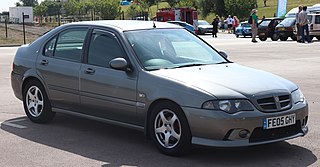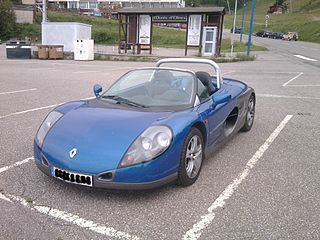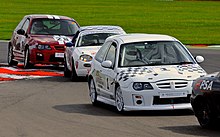
The Lotus Elise is a sports car conceived in early 1994 and released in September 1996 by the British manufacturer Lotus Cars. A two-seater roadster with a rear mid-engine, rear-wheel-drive layout, the Elise has a fibreglass body shell atop its bonded extruded aluminium chassis that provides a rigid platform for the suspension, while keeping weight and production costs to a minimum. It is capable of speeds up to 240 km/h (150 mph). The Elise was named after Elisa Artioli, the granddaughter of Romano Artioli who was chairman of Lotus and Bugatti at the time of the car's launch.

The Metro is a supermini car, later a city car that was produced from 1980 to 1998, first by British Leyland (BL) and later by the Rover Group. It was launched in 1980 as the Austin Mini Metro. It was intended to complement and eventually replace the Mini, and was developed under the codename LC8. The Metro was named by What Car? magazine as "Car of The Year" in 1983 as an MG, and again as the Rover Metro in 1991.

The SEAT León, also spelled Leon in some other languages, is a hatchback compact car built by the Spanish car manufacturer SEAT since October 1999.

The Rover 200 Series, and later the Rover 25, are a series of small family cars that were produced by British manufacturer Rover from 1984 until 2005.

The TVR S series is a line of sports cars manufactured by the British company TVR between 1986 and 1994. It was announced at the 1986 British International Motor Show. The car went into production in less than 12 months, with 150 pre-manufacture orders placed at the motor show before the moulds were even made.

The Lotus Exige is a sports car made by the British company Lotus Cars from 2000 until 2021. Originally a more-hardcore coupé version of the Lotus Elise roadster, since the Series 3 the Exige has been the larger-engined model of the family - using a V6 engine in place of the Elise's straight-four with convertible versions of both available.

The MG ZS is a sports family car that was built by MG Rover from 2001 until 2005. The ZS is essentially a tuned version of the Rover 45. The 45 in turn is a facelifted version of the Rover 400 which was launched in hatchback form in 1995 and saloon form in 1996, which in turn was derived from the Honda Domani.

The MGB is a two-door sports car manufactured and marketed from 1962 until 1980 by the British Motor Corporation (BMC), later the Austin-Morris division of British Leyland, as a four-cylinder, soft-top sports car. It was announced and its details first published on 19 September 1962. Variants include the MGB GT three-door 2+2 coupé (1965–1980), the six-cylinder sports car and coupé MGC (1967–69), and the eight-cylinder 2+2 coupé, the MGB GT V8 (1973–76).

The MGA is a sports car that was produced by MG from 1955 until 1962.

The Audi RS 4 is the high-performance variant of the Audi A4 range produced by Audi Sport GmbH for AUDI AG, a division of the Volkswagen Group. It sits above the Audi S4 as the fastest, most sports-focused car based on the A4's "B" automobile platform. The RS 4 was reintroduced in 2012, based on the A4 Avant instead of the sedan as did the original model.

The Audi S6 is the performance variant of the Audi A6, an executive car produced by German automaker Audi. It went on sale in 1994, shortly after the "A6" designation was introduced, replacing the "100" nameplate.

The Renault Sport Spider is a roadster produced by the French automaker Renault Sport, a subsidiary of Renault, between 1996 and 1999.

VXR is the branding for the high performance trim specification, used since 2004 for models in many of Vauxhall's car range in the United Kingdom. Holden has also used the VXR badge for some of its high-performance cars such as the Astra VXR, Insignia VXR, and the Commodore VXR.

The Rover T16 engine was a 2.0 L; 121.7 cu in (1,994 cc) fuel injected DOHC inline-four petrol engine produced by Rover from 1992 to 1999. It has a bore and a stroke of 84.45 mm × 89 mm. It is a development of the M series (M16), which was in turn a development of the O series, which dated back to the BMC B-series engine as found in the MG B and many others. Several variants were produced for various models, but all had the same displacement. The naturally aspirated type produced 136 bhp, and turbocharged types were available with 180 and 200 bhp.

The Rover 200 Coupé is a two-door coupé that was produced by Rover and based on the Rover 200 Mark II, with most of the body panels and the bumpers unique in the range. The car was launched on 6 October 1992, at the Paris Motor Show. It was given the project code name 'Tomcat' when in development.

The Renault Mégane Renault Sport is a series of high-performance hatchback models based on the Renault Mégane, produced since 2004 by the high-performance subsidiary company Renault Sport for its parent company Alpine, a subsidiary of Renault. The Mégane RS won awards such as "Best hot hatch" from What car? (2010–2014), "Highest placed non-supercar" in Evo's annual Car of the Year test 2011 and "Best hot hatch" from Top Gear.
Callaway Cars Inc. is an American specialty vehicle manufacturer and engineering company that designs, develops, and manufactures high-performance product packages for cars, pickup trucks, and SUVs. They specialize in Corvettes and GM vehicles. New GM vehicles are delivered to Callaway facilities where these special packages and components are installed. Then the vehicles are delivered to GM new car dealers where they are sold to retail customers, branded as Callaway. Callaway Cars is one of four core Callaway companies, including Callaway Engineering, Callaway Carbon and Callaway Competition.

The MG3 is a small car produced by the Chinese automotive company SAIC. The first generation, marketed as the MG3 SW, is based on the British made Rover Streetwise, which itself was based on the Rover 25, while the second generation, introduced in 2011 is marketed simply as the MG3. It is the most popular Chinese manufactured car currently on sale in the United Kingdom.

The TVR Tasmin is a sports car designed by Oliver Winterbottom (coach) and Ian Jones (chassis) for TVR and built in the United Kingdom by that company from 1980 to 1987. It was the first of TVR's "Wedge"-series which formed the basis of its 1980's model range. The Tasmin/280i was available as a 2-seater coupé, as a 2+2 coupé and as a 2-seater convertible.

Volkswagen R is the brand used by the German auto manufacturer Volkswagen to indicate a sport or high performance model. An "R" badge is placed on the grille, front fenders and trunk of R-model vehicles to indicate the vehicle's trim level.
























